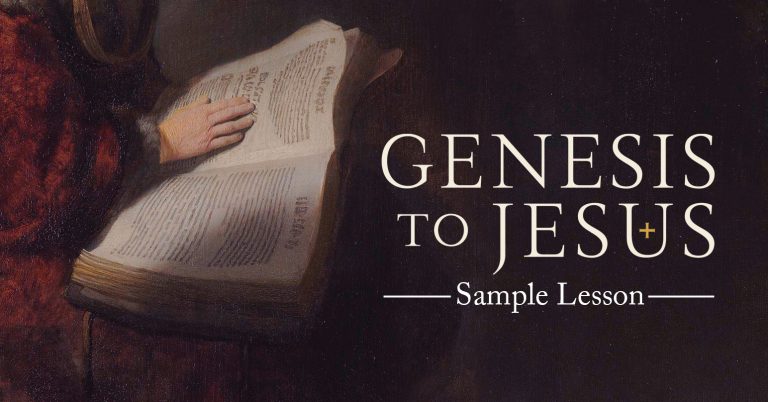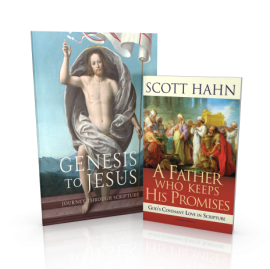
You don’t need a theology degree to read the Bible like a theologian. Watch Genesis to Jesus for free this Lent to learn more about salvation history and your important place in it! Sign up now to be notified as soon as lessons are available.
Understanding the Bible requires an understanding of its “plot.” And the Bible’s plot is the story of salvation history. It is the story of human salvation unfolding in history according to God’s plan. You and I need to read the Bible from the heart of the Church if we are to make sense of the Scriptures and apply them to our lives as Catholics. This includes an understanding of why we should read them and how we should read them.
Luke’s Gospel tells the story of two disciples who are traveling from Jerusalem to Emmaus on Easter Sunday. They are genuine believers in Jesus, but they are perplexed and discouraged by the events of Good Friday. Suddenly, they are joined by Jesus. Neither disciple recognizes who this “stranger” is until he begins to open the Scriptures to them. He explains that the Scriptures (the Old Testament) announce the coming of the Messiah, and that is was necessary to God’s plan that the Messiah should suffer before entering his glory. The two disciples are astounded and encouraged, yet they still don’t recognize this stranger as the risen Jesus (Luke 24:13–35).
Drawing near to Emmaus, the disciples urge their traveling companion to stay with them. He agrees and joins them for a meal. At table Jesus takes bread, blesses it, breaks it, and then gives it to the disciples—actions that immediately call to mind the events of the Last Supper, when Jesus took, blessed, broke, and gave the consecrated food to the disciples (Luke 22:14–30). Now at last the disciples dis-cover the Real Presence of Christ in their midst in the breaking of the bread, which is biblical language for the celebration of the Mass (Luke 22:31–35).
The Emmaus road story draws our attention to the role of the Scriptures and the Sacraments in the Christian life. Reading and interpreting the Scriptures caused the hearts of the disciples to burn, and the breaking of the bread caused their eyes to be opened. This is precisely what should happen to us during the celebration of every Mass: our hearts should be enflamed by Scripture, and our eyes should be opened to the presence of Christ in the Blessed Sacrament! Our worship offers us a personal encounter with the Word of God—the Word written as well as the Word made Eucharist.
The Bible is therefore a liturgical book. Its content is liturgical because it shows us God’s people praying and worshipping the Lord by means of sacrifice and praise. Its context is also liturgical because its books were collected and preserved for the express purpose of being proclaimed in the liturgy. We see this in the pages of the New Testament, where the apostles instruct believers to read their writings before the congregation (e.g., Col 4:16; 1 Thess 5:27; Rev 1:3). This is the essential meaning of the expression: “reading the Bible from the heart of the Church.”
Historically, there have been countless believers through the ages who never owned a personal copy of the Bible. Some lived before the Bible was a completed book. Others couldn’t read. Still others lived before the invention of the printing press and could not afford a hand-written edition. Nevertheless, from the very beginning of the Church’s history all believers had the opportunity to hear the Scriptures being proclaimed in the liturgy.
And notice that the Church reads from the whole Bible at Mass. We listen first to Old Testament readings from Moses and the Prophets, and then we listen to New Testament readings from the Gospels and the writings of the apostles. These readings prepare us to receive what the disciples traveling to Emmaus received: the Lord Jesus himself! When the priest takes, blesses, breaks, and gives the Eucharist to us, repeating the words of Jesus at the Last Supper, we are invited to recognize the risen Lord “in the breaking of the bread” (Luke 24:31, 35).
Before Jesus ascended to the Father, he announced that “the Spirit of truth” was coming into the world to lead his disciples into “all the truth” (John 16:13). How does the Spirit do this? In two ways primarily: the Holy Spirit inspires the writing of Scripture, and then he guides the Church to understand the meaning of Scripture.
The inspiration of Scripture means that God is the principal author of the book. Human authors were involved in composing the biblical writings as well, but the Spirit worked in and through them as they wrote, so that Scripture communicates the words of God in the words of men. Like Jesus himself, then, the Bible is both human and divine. Just as the Incarnate Word came into the world in a human nature without ceasing to be the divine Son, so the Inspired Word comes to us in human language without ceasing to be divine Speech. This is why the Church venerates the Bible just as she venerates the Body of the Lord.
The human authorship of Scripture means that the Bible is also a book of books. A variety of individuals living at different times in history contributed to the writing of Scripture, and they wrote in a variety of literary forms: prose, poetry, prophecy, proverb, apocalyptic vision, etc. More-over, it is clear from reading the Bible that the grace of inspiration did not suppress the personalities, talents, and perspectives of its human authors. So while the Scriptures are not merely human documents, they are truly human documents.
The guidance of the Spirit takes place in the Church, especially through the successors of the apostles—the pope and the bishops in union with him. This enables the Magisterium to be the “custodian” of the Word of God in all its forms, including the Scriptures. Relying on the Spirit’s guidance, the Church’s teaching authority is tasked with giving authentic interpretations of the Bible and with safeguarding the people of God against misunderstanding its message.
Unlike secular history, which restricts its focus to human actions and concerns, biblical history tells the human story from God’s perspective, with its focus on divine actions and concerns. God’s Word, then, is mainly about God’s saving work. The Bible gives us nothing less than the drama of salvation history told from God’s point of view!
Structurally, the Bible has two main parts: The Old Testament and the New Testament. The story of Scripture begins with creation (Gen 1:1) and ends with the glorious unveiling of a “new heaven” and a “new earth” at the end of time (Rev 21:1). At its center stands the cross of Christ. This means that salvation history is a two-part story. It’s an account of God’s promises before the coming of Jesus; and it’s an account of God fulfilling those promises in the life, death, and resurrection of Jesus, so that all of human history after his coming is marked by the redemption he accomplished.
Question for Review
What does it mean to “read Scripture from the heart of the Church”?
 The Genesis to Jesus participant kit is the essential toolbox you need to begin your study of Sacred Scripture. This kit not only includes the Participant Workbook, but also Dr. Scott Hahn’s bestselling book, A Father Who Keeps His Promises. Along with the Bible and the Catechism, A Father Who Keeps His Promises is highly recommended to help you supplement the information in the workbook.
The Genesis to Jesus participant kit is the essential toolbox you need to begin your study of Sacred Scripture. This kit not only includes the Participant Workbook, but also Dr. Scott Hahn’s bestselling book, A Father Who Keeps His Promises. Along with the Bible and the Catechism, A Father Who Keeps His Promises is highly recommended to help you supplement the information in the workbook.
If you already have A Father Who Keeps His Promises, the Participant Workbook is available separately. The Participant Workbook for Genesis to Jesus will serve as your companion for the duration of the series, helping you better retain what you’ve learned so that it can more easily be applied to your daily life.

